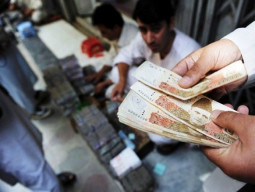
A critical review of the IMF’s Article-IV report on the state of Pakistan’s economy reveals fundamental contradictions and formal projections of the external sector. The estimates of gross external financing requirements, current account deficit, balance of trade and gross official foreign currency reserves do not match with the warnings that the IMF has given while discussing these issues in the report.
IMF data bloats Pakistan forex reserves by $3bn
The IMF released the report on Thursday - a month after its Executive Board gave its approval. Even optimistic projections of the external sector have shown the external debt at $87.1 billion including $67.3 billion external public debt.
“External vulnerabilities have increased with a widening current account deficit and rising medium-term external repayment obligations,” said the IMF in its report. It also noted that external financing needs are expected to pick up amid a widening current account deficit. Rising imports, stagnant remittances, and weakly recovering exports are weighing on the current account deficit.
However, when it came to translating these issues into formal projections, the IMF has somehow painted an optimistic picture.
The IMF has projected Pakistan’s gross external financing requirements for fiscal year 2017-18 at $16.2 billion, which is even a billion dollar less than the last fiscal year. The $16.2 billion figure has been worked out by assuming that the current account deficit will be equal to 3.2% of the Gross Domestic Product or $10.1 billion. The external debt payments including short-term have been estimated at $6.2 billion.
Although the final current account deficit figure for last fiscal year is not available yet, the central bank reported the eleven-month deficit at $10.6 billion or 3.8% of the GDP. The Planning Commission officials said that the current account deficit for the full year would be close to $11.5 billion or 4.1% of the GDP for last fiscal year. This will be 250% more than the official projection of the government.
For the new fiscal year, the government has pitched the current account deficit figure at roughly $9 billion or 2.6% of the GDP. The independent estimates show that the current account deficit would be close to $13.5 billion - $3.5 billion higher than the IMF’s projection, for the fiscal year 2017-18.
The gross external financing requirements would increase by the same amount to roughly $19.7 billion, said Dr Hafiz Pasha, the former finance minister. He said that the mismatch between the IMF analysis and its formal projection was primarily because the Fund did not want to scare investors in an election year.
Against the backdrop of a record trade deficit of $32.6 billion in the last fiscal year, the IMF has painted a rosy picture of the trade sector in the new fiscal year. This is despite the fact that government does not have a plan to address issues leading to constant reduction in exports and mushroom growth in imports.
The IMF has projected over 9% growth in exports in the new fiscal year as against 1.63% reduction in the last fiscal year. The Fund has advocated significant devaluation of Pak rupee against the US dollar to make Pakistani exports competitive in the global market. Contrary to this, Finance Minister Ishaq Dar has formally launched an inquiry to find out the reasons behind 3.1% deprecation of local currency on July 5 that he got reversed by influencing the market.
The IMF has projected almost 7% growth in imports in the new fiscal year, which is less than half of the growth rate that Pakistan witnessed in the last fiscal year. The IMF acknowledged surge in imports in the new fiscal year due to China-Pakistan Economic Corridor-related imports but it did not translate this surge into projections.
Against $16.2 billion gross external financing requirements, the indicated inflows in the IMF report totalled to roughly $11 billion, leaving a financing gap of $5.2 billion even after taking an optimistic view. Yet, the IMF has shown the gross official foreign currency reserves at $18.9 billion by end of the new fiscal year, higher than last fiscal year’s reserves of $16.1 billion.
After taking into account the $19.7 billion gross external financing requirements by assuming relatively realistic current account deficit, the financing gap will be close to $9 billion, which will either have direct bearing on the official foreign currency reserves or the external borrowings will significantly increase.
Global lender warns of risks to Pakistan’s economic stability
“My professional estimates suggest that Pakistan’s gross official foreign currency reserves will slip below $10 billion,” said Dr Pasha. He said that the IMF report showed the reserves at $18.5 billion by June 30 of this year, which actually were $16.1 billion.
The IMF has shown the gross external debt of Pakistan at $87 billion in the new fiscal year by taking a relatively optimistic view of the current account deficit and official foreign currency reserves.
Published in The Express Tribune, July 15th, 2017.
Like Business on Facebook, follow @TribuneBiz on Twitter to stay informed and join in the conversation.

































1714024018-0/ModiLara-(1)1714024018-0-270x192.webp)









COMMENTS
Comments are moderated and generally will be posted if they are on-topic and not abusive.
For more information, please see our Comments FAQ